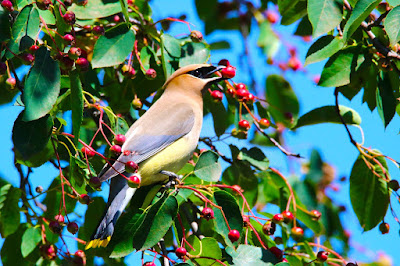Adams recommends growing plants that feed birds and provide them with shelter.
 |
| Cedar waxwing eating fruit of a native serviceberry |
He’s not a fan of bird feeders in the warm months. He points out that bird feeders can attract aggressive birds and invasive bird species like European sparrows that hog all the food and drive away shyer birds. Rodents attracted by birdseed may eat eggs and baby birds.
To tell the truth, I was beginning to feel that birds were eating us out of house and home. Flocks of European sparrows showed up every time I filled the feeders and snapped up all the food within a few hours. While I regard individual sparrows as having a legitimate right to live, even if their ancestors are not from North America, I was attracting too many of them and not feeding other species I’d like to welcome to my yard.
 |
| One sparrow is endearing. Twenty take over a bird feeder. |
Following Adams’ advice, I started to emphasize trees, shrubs, and perennials whose fruit and seeds would provide food for birds. I already had some of them: balsam fir (Abies balsemea), shadblow (Amelanchier arborea), trumpet honeysuckle (Lonicera sempervirens), and lowbush blueberry (Vaccinium corymbosum). I added American elder (Sambucus canadensis) and American cranberry (Viburnum trilobum) for more bird-friendly fruit.
 |
| Mockingbird finds winter berries |
While I was choosing native perennials to attract native insects, I threw in some Eastern purple coneflowers (Echinacea purpurea), sunflowers (Helianthus species), and milkweeds (Ascelepias species), whose seeds birds could eat.
 |
| Purple coneflower seeds feed goldfinches |
One of Adams’ warnings was that birds might become dependent on food from feeders. If I suddenly stopped putting out seed, perhaps they would starve. I was interested to read an article in this month’s Atlantic that cites a Wisconsin study showing this didn’t happen in a population of black-capped chickadees.
 |
| Black-capped chickadee--photo Alain Wolf |
Researchers compared mortality among birds accustomed to getting some of their food from feeders and birds that foraged completely on their own. When feeder food stopped being available, the birds that had been fed did just as well as they had before. They were only taking 21 percent of their food from the feeders, continuing to forage widely despite this food source. Bird feeders did help the chickadees get through the worst winter weather.
 |
| Bird feeders help birds survive the coldest days |
Scientists have also found that birdseed provided by humans is influencing birds’ evolution. Species are developing heavier beaks for opening sunflower seeds they find at feeders but not in their natural habitat.
This year I’m putting out birdseed only in winter. I was happy to see that the native birds soon reappeared at the feeders this December, but the European sparrows aren’t back. I can’t judge yet whether more birds or bird species have been attracted by my plantings. All I can say is, there are lots of birds flitting around in spring and summer. I hope I’m heading in the right direction.
 |
| A sight I'd like to see |
No comments:
Post a Comment